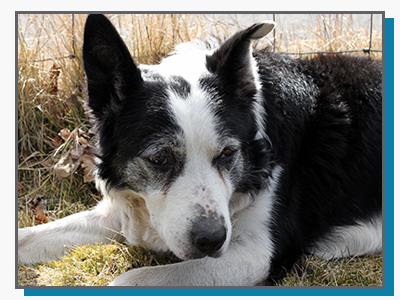Treating and Preventing Arthritis in your Pet
by Juliette Veenstra, RVT

Most dog owners (and their humans) will eventually have to deal with the pain and debilitation of arthritis. For most dog owners, this disease process will likely eventually affect the dog-human activities that they love (either by affecting the dog or the handler). While some degree of arthritis is a near inevitability, there are things owners can do to delay onset, slow the progression and ease the pain once the disease sets in.
Since arthritis can affect both animals and humans, understanding the disease is equally important for dogs and their people.
What is Arthritis?
“Arthritis” is a very broad term covering 100+ disease processes. It is most commonly a disease of the joints, although certain forms also affect other connective tissues and organs. When we refer to “arthritis,” we are usually referring to a condition technically called “osteoarthritis” or OA. For the purposes of this article, we will be referring specifically to that form of arthritis.
Osteoarthritis occurs when the protective ends of your bones (called “cartilage”) begin to break down or wear away, leaving the bone ends to rub against one another. The result is inflammation, pain and morphologic degenerative changes to the joint.
Joints:
To understand osteoarthritis, it is helpful to have a rudimentary understanding of joint structure. On a basic level, a joint is a place where two bones meet. The purpose of a joint is usually to allow for movement in that part of the body. Knees, knuckles, elbows, shoulders, ankles and spinal vertebrae are all examples of joints within the body.
Cartilage:
Cartilage is the protective cushion that caps the end of the bone within a joint. This semi-hard tissue not only cushions the joint during use, it also provides for smooth
motion of the joint. When lubricated with “joint fluid,” cartilage is very slick, which provides for easy, gliding motion of the joint.
The joint is encapsulated in a pocket of tissue known as the “joint capsule,” which holds in the joint fluid. This viscous fluid, known as “synovial
fluid” serves a very important role in the joint. As mentioned earlier it helps lubricate the joint so the joint is able to move smoothly. In addition, synovial fluid
provides nutrition and hydration to the cartilage, which does not has a blood supply and therefore must absorb it’s nutrients from the fluid. Finally, joint fluid acts as further
padding for the joints, helping to absorb “shock” from running, jumping, etc.
Joints are held together by sinewy tissue called ligaments. They not only provide connection, but provide stabilization as well. Cartilage insures that the bones
stay “in place” and move only the way that they are designed to.
Joints are relatively precise structures. The bone ends have complementary shapes, allowing for easy motion without too much rubbing. The structures mentioned above all contribute
to correct and efficient joint motion, meaning that damage or change to any one of them can begin the arthritis process.
The role of Inflammation in Animal Arthritis:
In the body there are two forms of inflammation: acute (short lived) and chronic (long lived). The acute form is important for many body functions including healing and digestion.
Chronic inflammation can be damaging and dangerous. Body-wide chronic inflammation can lead to a variety of physical problems including depression, cancers, COPD, heart
disease and decreased immunity. In the joints, chronic inflammation actually signals the physical changes that result in bone spurs and further breakdown of
the joints.
Somewhat ironically, the breakdown of cartilage begins the chronic inflammatory process in an arthritic joint. This signals the bony changes (“bone spurs”) that develop in an arthritic
joint, which leads to more inflammation, leading to more degenerative changes, etc. This is why arthritis is a cyclical and continuous process.
Causes of Arthritis:
Wear and Tear:
By far the most common cause of arthritis is natural wear as tear. As we age, cartilage simply becomes less healthy. It loses thickness, strength and structure. When this happens
it simply begins to break away more easily, leaving the bone exposed. The more we can do to keep our cartilage healthy, the more we can help delay this process.
Excess Weight:
Few experts would argue that one of the greatest risk factors for arthritis is excess weight. Being overweight not only causes early onset of the disease, but it can result in faster
joint degeneration for two reasons. The first is simple physics. Being forced to bear excess weight simply puts more strain on the joints than they were designed to handle.
The second reason is a surprise to most people. Fat is not a static structure, but rather an active organ that secretes hormones and protein factors known as
adipokines. These signal physical responses in certain parts of the body, one of the most concerning of which is a form of chronic inflammation called
Adipokineschronic inflammation. Because arthritis is itself an inflammatory condition, anything that makes inflammation worse, makes arthritis worse.
Injury:
As mentioned, the joint is a fairly precise structure. Anything that damages any of the protective and mechanical functions of the joint can result in cartilage breakdown and subsequent
joint degeneration. This most commonly is seen following certain fractures and ligament damage.
Infection:
Although not exceptionally common, infections in the joint cause inflammation and can damage cartilage. If serious enough, they can have permanent effects on a joint.
Genetic Predisposition:
The most common causes of early-onset arthritis in dogs are genetic conditions. Dysplasias (hip, elbow, shoulder) are conditions where the joint is basically malformed from
puppyhood. As a result of this malformation the joint ends don’t “fit” against each other correctly, resulting in cartilage breakdown.

Prevention of Arthritis:
While the majority of dogs will eventually suffer from some form of arthritis, there are things any owner can do to keep their pet (or themselves) healthier longer:
Keep them Lean:
by now it should be no surprise that keeping a body lean can delay the onset of arthritis (and a lot of other problems). In dogs, that means keeping them at or just below ideal
weight: You should be easily able to feel your dog’s ribs without pushing. From a top view, dogs should have some narrowing just behind the rib cage (varies a little by breed),
and nearly all breeds should have a significant “tuck” behind their rib cage when looking from the side.
Keep them “Fit”:
Healthy muscles and trained body-awareness can help protect joints from injury and can even aid ligaments in keeping joints stable. Make sure your dog is exercised regularly. For
sports dogs, body conditioning exercises can be key in preventing sports-related injuries. “Weekend Warrior” type dogs are more prone to injury as they may participate in activities that
their bodies are not trained to do.
Omega 3 Fatty Acids:
These essential fatty acids derived from marine sources help decrease inflammation while helping many other parts of the body by keeping cell membranes healthy. Omega 3 Fatty Acids tend
to be very deficient in both dog and human diets. Most professionals agree that all pets and humans can benefit from supplementation.
Signs of Arthritis in Pets:
Inflammation in the body usually equals pain (think of the nerves being squashed by inflamed tissue), so most signs of arthritis are related to pain. These include difficulty or unwillingness to get up, stiff gait, limping, reluctance to jump or go up stairs, shaking limbs or a hunched stance.
Diagnosis of arthritis is most accurately done with a veterinary exam and X-rays of the affected area.
Treatment of Arthritis in Pets:
Once arthritis has started, we are left with slowing the progression and easing the symptoms. Luckily over the last few decades arthritis has become a very hot topic in dog health, so we have many options to choose from.
Slowing the Changes:
There are several supplements that can help keep cartilage healthy and can slow the changes associated with arthritis. Please note that there is very little regulation in the
supplement industry. Make sure to purchase your products from a trusted, reputable source. Very often you do get what you pay for and generics may not always be the best
option.
Omega 3 Fatty Acids:
As mentioned before most animals benefit from Omega 3 supplementation. For those suffering from arthritis, increase supplementation to twice the recommended “maintenance” dose.
Note: pets on too high a dose of Omega 3s usually present with diarrhea. If this happens to your pet when on a new dose of these oils, try decreasing the dose.
Glucosamine/MSM/Etc:
There are a variety of Glucosamine-based supplements on the market. While this product does not seem to have any negative effects, opinions are mixed as to whether or not they provide
benefit to dogs. This is partially due to concerns that dogs do not metabolize this supplement in the same way as humans do. Additionally, because there is little to no regulation
in the supplement market, the actual content of these products can be questionable. Still, they do not seem to hurt and many do contain other beneficial supplements that may help
joints.
Adequan/Polysulfated Glycosaminoglycan:

This injectable product is perhaps one of the only studied and FDA approved OA inhibiting supplements on the market. This product travels to the joint to help thicken joint
fluid while inhibiting the activity of certain enzymes which lead to cartilage destruction. While this product will not help regrow cartilage, it has been show to slow its degradation while
thickening the synovial fluid to protect the joint.
Weight and Fitness:
Once your pet has arthritis, keeping them lean and fit is all the more important. For the same reasons mentioned above, a healthy body can slow arthritic changes and keep pain at a
minimum.
Managing Pain in Arthritic Pets:
At some point, most animals will have some pain related to inflammation in arthritic joints. Pain from arthritis can vary from mild to severe, and can change from day to day. It
can act as a mere nuisance or severely affect a pet’s quality of life. Many owners do not even realize how much their old dog was suffering until they begin treatments and find they
have a “new dog”!
NSAIDs:
When it comes to pain management, experts agree that simply nothing beats the pain-reducing power of a class of drugs known as Non Steroidal Anti Inflammatory Drugs. In
humans, this class includes Asprin, Ibuprofen, Celebrex and the like. In dogs, it includes Rimadyl/Carprofen, Metacam/Meloxicam, and Deramaxx. These drugs work by decreasing
specific inflammation in the body. Because inflammation = pain, reduction in inflammation means a reduction in pain. Additionally, because arthritis gets worse as a result of
inflammation, some experts believe that regular use of NSAIDs may slow the progression of this disease.
Some patients experience GI side effects (vomiting/diarrhea) when using NSAIDs. These effects are rare, but if seen, stop the medication and contact your veterinarian.
Additionally, as the kidney and liver are key in metabolizing these (and many other) medications, animals with existing kidney or liver insufficiency should not use these medications.
Pets who use NSAIDs chronically should have their blood tested regularly to monitor early signs of kidney or liver disease. Finally, animals on steroids (such as prednisone) should
never take NSAID medications. Steroids can significantly alter the protective functions of the GI tract. Using NSAIDs while on steroids can result in stomach and
intestinal ulcers.
All of that being said, the vast majority of dogs handle chronic use of NSAIDs very well and thousands of patients use them chronically to effectively ease arthritis pain and improve quality
of life.
Do NOT use human NSAIDs (Aleve/naproxen, ibuprofen, etc) on dogs as they do not metabolize them well.
Note: NSAIDs are very good options for pain control in dogs and many exotics, however they are not nearly as well tolerated by cats. Long-term use of NSAIDs is not
usually our first option for pain control in pet cats.
*New* Piperant Class Drugs:
Galliprant is a new medication that has recently been approved in dogs for the control of pain and
inflammation associated with osteoarthritis in dogs. Galliprant works similarly to NSAIDs but blocks the inflammatory response at a different site in the body and, as a result, is
expected to have even fewer side effects than we see with standard NSAIDs.
Tramadol:
Tramadol is an opioid-like pain medication which simply blocks pain signals in the brain. Efficacy seems to vary, with some dogs having decent pain reduction and some seeing little
effect. Tramadol is however, considered fairly safe with few side effects or long-term concerns. It can cause some drowsiness, although effects are usually temporary.
Tramadol is safe to be given with most supplements as well as will NSAIDs and Gabapentin.
Gabapentin:
Gabapentin is an antiseizure medication that blocks the signals that nerves send to the brain. The goal is to prevent the “pain signal” from ever reaching the brain, meaning the dog
doesn’t feel it. Dogs can be drowsy when they first start Gabapentin, but most get used to the sleepy effects after a week or so, and the dose can be reduced to account for this.
Gabapentin seems to be very safe and can be given with a variety of medications and supplements (including all those mentioned above).
Rehabilitation:
Keeping the body moving is key to keeping joints as healthy as possible for as long as possible. Joint movement signals cartilage to stay thick and healthy, meaning healthier
joints. Rehabilitation also helps improve muscle strength and proprioception (body awareness), which ultimately helps protect joints. Rehab such and underwater treadmill and swim
therapy provide low impact exercise which keeps joints moving while helping to burn calories to help keep your dog thin & fit!
Integrative Medicine:
Therapies such as laser, electrostimulation, and therapeutic ultrasound have all been shown to have beneficial effects on arthritis pain. In addition, these therapies are
considered very safe and can be added to enhance the effects of almost any comprehensive treatment regimen.
There are many treatments for arthritis in both dogs and humans. Ultimately which ones you choose and use should be based on the severity of symptoms, how well treatments are tolerated, and which treatments are going to be the most effective within the realistic constraints of your budget. Ultimately, our goal is to make sure our pets stay happy and pain free for as long as possible!




